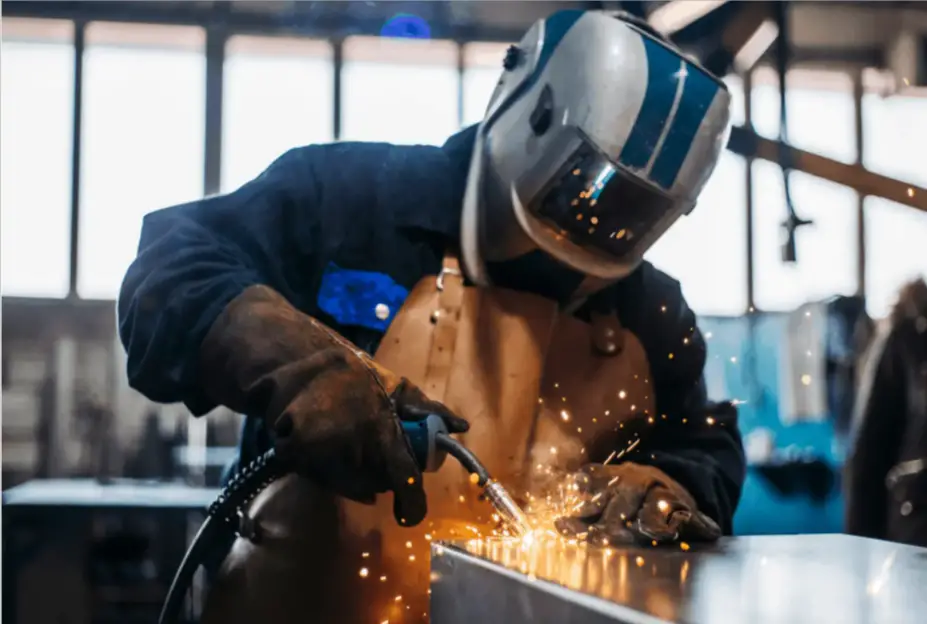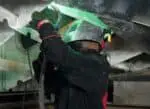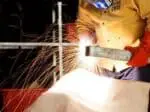Fire is something that a welder deals with on a regular basis. This is why they have to ensure that they are fully protected with welding safety clothes and equipment, as well as how to receive the most protection possible while on the job.
Flame resistant fabrics are apt for welding as they are constructed of self-extinguishing materials that prevents it from catching fire, which means it does not continue burning when the external ignition source is removed.
The qualities are obtained by chemical treatment or because the fibres are naturally fire resistant.
But when you hear the term FR clothes, it might get a little confusing.
Why?
Because this is often divided into two major groups. You have both Flame Resistant and Flame Retardant fabrics.
And what is the distinction between these two?
Let’s find out.
Flame resistant
Flame Resistant clothing indicates that the fabric is physically composed of resistant material. Even if you tried, you couldn’t get the flame-resistant component of the cloth out as they are inherently flame resistant.
No matter how many times you wear or wash flame-resistant clothing, it will retain its self-extinguishing capabilities.
Flame-resistant clothing will catch fire if it comes into touch with flames. However, because of the materials utilised to construct the clothes, the fabric swiftly self-extinguishes.
The cost of flame-resistant clothing is generally higher than flame retardant fabrics. This is due to the fact that it is manufactured with unique materials. The cost varies according to the type of clothing required.
Different PPE will be more expensive than others. If you operate in a field where you are frequently exposed to open flames, it is worthwhile to invest in flame-resistant PPE.
Flame Retardant
Flame retardant clothing, on the other hand, has a fire-resistant coating. The difference between it and flame-resistant clothing is that after the fire-resistant coating wears off, the piece of clothing becomes simply another piece of fabric or cloth. Items that are flame/fire retardant are not inherently flame-resistant.
To become flame retardant, they must be chemically treated.
Flame retardant clothing, as opposed to flame-resistant clothing, is created using standard garment materials. The unique chemicals applied to the clothing are responsible for their ability to shield you against burns.
Fire retardant clothing is somewhat less expensive than naturally flame-resistant textiles since it is created from a wider range of materials and then treated to become flame-resistant.
Why do you need FR clothing while welding?
Okay, let’s keep things as simple as possible. The first step is to ensure that you are entirely protected from the damaging UV rays produced by a welding arc.
However, the cost difference between a standard jacket and a FR welding jacket is negligible when weighed against the benefits. You will, statistically, have an accident at some time. Good protection with FR gear ensures that the mishap does not prove to be fatal.
Finding dependable FR apparel is difficult. Just because a brand is pricey does not imply that they are investing that much money in their product. Therefore, always go for brands that have good reviews and are reliable.
Advantages-
-
-
- Thermal dangers are adequately protected.
- Electrical safety.
- FR clothes are strong so they protect against cuts and abrasions too.
- Durable.
- FR characteristics will never be washed away in flame resistant clothes.
- Lightweight.
-
What is FR fabric made of?
Not all flame-resistant clothing is made of the same materials. There are several options accessible, each with its own set of advantages and disadvantages.
Most flame-resistant clothing is made of a combination of many different materials, virtually often synthetic. Because of their thorough engineering and design, they are self-extinguishing and take a long time to ignite, therefore, a safer option.
Here are a few examples of typical fabrics with inherent flameproof properties that are widely used to make FR garments.
1. Modacrylic: Among the most popular and widely accessible alternatives today, these fibres are frequently used in a blend to make a variety of flame-resistant textiles.
These numerous fibre combinations work together to generate textiles that can readily withstand a variety of standards and requirements.
2. Nomex: Another fabric with intrinsic flame resistance is Nomex. Unlike modacrylic fibres, Nomex may be used to make FR clothing on its own. It does not have to be used alone as it can also be used with other materials such as Kevlar.
3. Kevlar: These fibres are flame-resistant, but they also have many other features, such as great strength and durability.
Each type of flame-resistant cloth has its own set of advantages and disadvantages. Kevlar, for example, is extraordinarily strong but also expensive.
There are no unique hazards associated with flame-resistant clothes, and all can protect the user against dangerous heat-based circumstances.
According to OSHA
The Occupational Safety and Health Administration, establishes particular requirements. And any fireproof clothing needed by a business must adhere to these requirements.
OSHA requires that any person working in settings that might expose them to fires, electric arcs, or other dangers not wear apparel that “could exacerbate the amount of harm.”
OSHA’s FR clothing regulations then go on to ban clothes composed of rayon, nylon, polyester, or acetate, unless the employer can demonstrate that these materials have been treated to become fire resistant in order to keep the employees protected.
Things to avoid while wearing FR clothing
Okay, now there are some rules that must be followed while you’re wearing FR clothes. Here are some of them-
1. Do not wear a non-FR synthetic fabric underneath.
One thing to remember is that when you wear FR apparel, you should also wear a FR underlayer. T-shirts made of polyester or synthetic fabrics can aid with moisture management, but they are not flame resistant and can melt on the skin.
2. You should not roll up your sleeves.
While this might be difficult, especially if you’re trying to avoid the heat, pulling up your sleeves exposes your arms to welding spatter. The best option is to go for lightweight FR clothes to ensure optimal comfort and protection.
3. Wearing FR garments without a non-FR outer layer is prohibited.
You must ensure that you are wearing a FR upper layer when wearing FR apparel. It is tempting to wear a non-FR jacket, especially in chilly weather. However, that upper layer may still ignite and burn, placing you in danger.
4. Keep your shirt tucked in.
When wearing welding clothes, make sure your shirt is correctly tucked in. If not, heat and flame can escape and cause further harm. When purchasing FR apparel, be certain that it is designed with long shirttails.
5. Do not Unbutton your FR clothes.
It’s critical to understand that unbuttoning your FR clothes exposes your skin to heat and welding spatter. Heat may readily ignite and burn if you’re wearing non-FR clothes beneath, for example, leaving you vulnerable.
FAQs-
What are the dangers of FR fabrics?
Because of the chemicals used to treat them, flame-retardant textiles can be harmful. For example, FR clothes containing formaldehyde may cause health problems like rashes or possibly some form of skin cancer.
The National Institute of Environmental Health Sciences has identified the most harmful forms of flame retardants to assist you in avoiding poisonous items.
Choosing FR trousers, shirts, or jackets made of naturally flame-resistant fibres over materials treated with dangerous chemicals will help you avoid burns without jeopardising your general health.
How long will your FR clothes last?
It is hard to make a general statement on the durability of any flame-resistant apparel. The manufacturer, the quality of the garment and the type of fabric used, how frequently you wear the garment, and how much wear and tear it suffers are all elements that might impact the longevity of FR apparel.
Some types of flame-resistant clothing can last up to five years, while others burn out and need to be replaced in as little as 3-4 months.
When your flame-resistant clothing is destroyed beyond repair, becomes contaminated, or is no longer functioning, it is time to replace it.
Conclusion
It is essential to wear FR clothes while welding in order to keep yourself safe and protected against the hazards of welding. In this article, we have included all that you need to know about FR clothes and its varieties.
It is extremely important to keep yourself safe while working since welding involves working with heat and melted metals which can be extremely dangerous for you.







